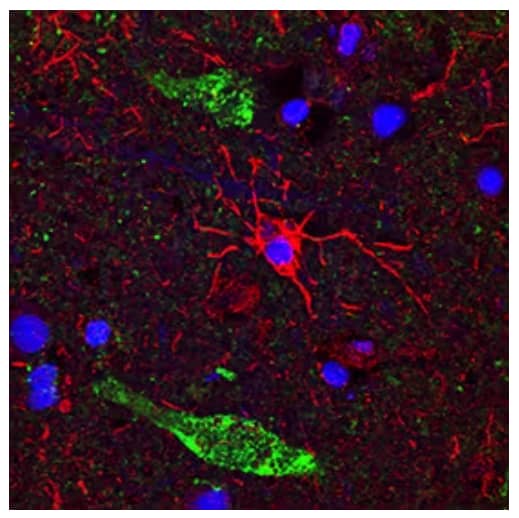What is the Cellular Role of the CD11 Protein?
The CD11 protein is actually a heterodimer complex that consists of CD11b and CD18. CD11 is involved in numerous adhesion-related associations between cells such as monocytes, macrophages, natural killer (NK) cells, and granulocytes. CD11 also regulates the uptake of complement-coated particles within cells. It has also gained usage as a microglial marker for tissues derived from the nervous system.
Research Studies Using CD11b Antibodies in the Tumor Microenvironment
Immunoblotting with the CD11b antibody from Wong's lab at Johns Hopkins demonstrates that the hypoxia-inducible factor 1 (HIF-1) drives breast cancer metastases by establishing a tumor-conducive lung niche microenvironment (intratumoral hypoxia and decreased collagen cross-linking) before secondary tumor cells seed to the distant locations (1). This same research group also used the CD11b antibody in later studies with the HIF inhibitors digoxin and acriflavine (2). There, they determined that both drugs were equally effective in an orthotopic breast cancer model they established. Both compounds could be aggressive therapeutics due to their ability to block metastatic niche formation and lung metastases.

CD11b/Integrin alpha M was detected in immersion fixed paraffin-embedded sections of human brain (cerebral cortex) using Mouse Anti-Human/Equine CD11b/Integrin alpha M Monoclonal Antibody (Catalog # MAB16991). Before incubation with the primary antibody, tissue was subjected to heat-induced epitope retrieval using Antigen Retrieval Reagent - Basic (Catalog # VCTS021). Tissue was stained using the NorthernLights™ 557-conjugated Anti-Mouse IgG Secondary Antibody (red; Catalog # NL007) and counterstained with DAPI (blue). Specific staining was localized to cytoplasm of microglia. Tissue was co-stained with using a Sheep Anti-Human/Mouse/Rat Neurogranin Antigen Affinity-Purified Polyclonal Antibody (Catalog # AF7947) and an Alexa Fluor® 488-conjugated Donkey Anti-Sheep IgG Secondary Antibody (green). View our protocol for Fluorescent IHC Staining of Frozen Tissue Sections.
Neuroscience Studies Utilizing CD11b Antibodies as a Microglia Marker
Interesting work from the Mayo Clinic focused on Alzheimer's disease (AD) and used the CD11b antibody for both immunoblotting and flow cytometry experiments (3). These scientists methodically dissected the effects of murine IL-6 (mIL-6) on amyloid beta deposition, gliosis, and resultant phagocytic inflammation. Columbia University Medical Center researchers examined the role of Munc18 in schizophrenia using CD11b antibody immunoblotting (4). With their mouse model, they were able to replicate a similar cytokine expression pattern profile to the naturally occurring disease condition, as well as implicate cytokine immune imbalance involvement in this disorder. The CD11b antibody also allowed Malmevik et al. to demonstrate the ability of their antibody-based, non-viral vector to selectively yet transiently target brain microglia (5). This recent work is promising because there are currently relatively few technical means of achieving this specificity and efficiency in this cell cohort.
Bio-Techne offers CD11b reagents for your research needs including:
PMIDs
- 21911388
- 22231744
- 19825975
- 25069615
- 25150592
Note: Some headings, titles, links, and images in the blog were updated in January 2023.